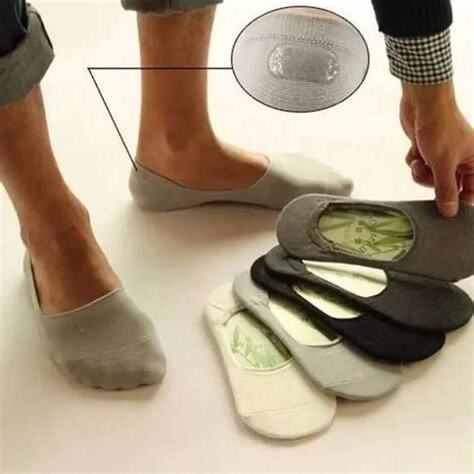「趕時髦人喜歡不穿襪子就穿鞋,把腳踝裸露出來。最近幾年,穿鞋不穿襪子的“潮人”比例大幅提高,無襪穿鞋甚至已經成為時尚人士的主流,即使在寒冷的冬季很多人也是如此穿着。穿襪子可以幫助減少汗水,並防止腳臭和水泡,合適的襪子可使鞋更加舒適。穿鞋不穿襪子,由於排汗增加,會在鞋裏產生難聞的氣味。尤其是運動鞋,因為出汗而引起的水分增加會為產生異味的細菌提供“温牀”,從而導致腳臭又痛。腳部真菌感染的其它症狀還包括腳趾間的瘙癢,以及腳部皮膚發紅、乾燥、鱗屑、龜裂或起水泡。
foot care in fashion: the rise of sockless shoe-wearing
In recent years, the trend of wearing shoes without socks has soared, with more and more fashion-conscious individuals embracing this style. Even in colder seasons, many choose to go sockless as it has become a prevalent choice among the stylish set.
- Benefits of Wearing Socks:
- Socks help absorb sweat and prevent foot odour.
- They create a barrier between the foot and the inside of the shoe, reducing the risk of bacterial growth and subsequent foot odour, particularly in athletic shoes.
- Socks can prevent blisters and skin irritation caused by friction between the foot and the shoe.
- Fashionable Debate:
The argument over whether socks with sandals are chic or not continues to be a topic of discussion among fashion enthusiasts.

- Microbial Concerns:
A study of the debris inside an old, worn-out pair of shoes would reveal a plethora of bacteria, with the primary threat being the fungus responsible for athlete’s foot. This fungus thrives in dark, warm, and poorly ventilated environments, such as the inside of shoes.
- Preventing Athlete’s Foot:
- Wearing socks can prevent the transfer of fungus from the shoe to the skin or nails.
- Socks absorb sweat and facilitate evaporation, reducing the moisture that encourages bacterial growth.
- Ancient Greek Footwear:
Contrary to popular belief, ancient Greeks did wear shoes, primarily sandals, but not socks. It is said that the hero Theseus received a pair of sandals as part of his coming-of-age gift. Shoes were a luxury, often reserved for the wealthy, including emperors. In many period dramas, citizens are often depicted walking barefoot in the city, not because it was common practice but because socks were a luxury item that only the affluent could afford. The lack of socks may have had an impact, as evidenced by the adoption of toecaps by Roman soldiers, a more advanced society. While the exact role of socks in history is not clear, the acceptance of sock-wearing has been a gradual process. In European history, the term “sock” (sock) has been in use for a long time, initially referring to stockings (hose) worn by men. The original meaning of “sock” denoted the most distal part of the body. By the 15th century, the term “stocks” was used to describe the lower part of the body, similar to tights (tight), which later evolved into breeches (breeches) and “nether-stocks” (stockings).
The rise of sockless shoe-wearing is a reflection of changing fashion trends, but it’s important to remember the benefits of wearing socks for foot health and hygiene.
我想到了自由、勇敢以及獨特。不穿襪子的人是那些敢於與眾不同的人,他們拒絕被束縛,選擇以自己的方式生活。
他們穿著涼鞋,腳趾球球地擺動,洋溢著自由與輕盈的感覺。這些不穿襪子的人總是能在眾人之中脱穎而出,不僅因為他們不按常規行事,而且他們擁有自己獨特的風格。
他們可能是藝術家、創作者或冒險家,他們勇於探索未知的領域,不斷挑戰自己的極限。他們相信自己可以改變世界,並用他們的熱情和創造力推動著社會的進步。
不穿襪子的人經常受到質疑和批評,有人覺得他們是叛逆的代表,有人認為他們是不負責任的。然而,他們並不在乎他人的評論,他們相信自己的選擇是正確的,這種自信使他們更加堅韌。
他們的生活方式也反映在他們的思維方式上。他們擁有開放的思想,願意接受新的觀點和想法。他們鼓勵創新和獨立思考,他們相信每個人都應該擁有自己的聲音和意見。
不穿襪子的人教會了我們一個重要的道理:不要讓常規限制我們的想像力和行動。生活是短暫的,我們應該用自己的方式活著,追求真正讓自己快樂的事物。
當我們面對壓力和困難時,不妨學習一下不穿襪子的人的精神。他們鼓勵我們超越自己的舒適圈,勇敢地面對挑戰,相信自己的力量。
不穿襪子的人給我們帶來了鼓舞和靈感,他們的存在提醒我們要堅持自己的價值觀,不要被社會的期待所束縛。讓我們向這些敢於不同的人致敬,並從他們那裡學到更多關於生活的意義。
延伸閲讀…
長期不穿襪子有什麼危害?
會有穿鞋不穿襪的習慣嗎?
